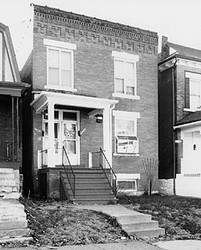Shelley House, Part of the Landmark 1948 Decision in Shelley v. Kraemer
Introduction
Text-to-speech Audio
This home was once in a predominantly white neighborhood and part of the deed specified that it could only be occupied by white residents. J. D. Shelley purchased this home from an owner who agreed not to enforce this part of the deed, but area whites protested and attempted to force the Shelley family out of the neighborhood. Despite death threats, the family chose to remain and fight in the courts. The practice of attempting to legally prevent minorities from owning real property, known as a restrictive covenant, was common both before and after the landmark decision in Shelley v. Kraemer.
The home is a private residence but is also a National Historic Landmark because it was connected to the landmark ruling declaring that racially restrictive covenants could not be enforced by American courts because they violated the 14th Amendment's guarantee of equal protection of law.
Images
The house is a private residence located on a quiet street lined with similar structures in the predominantly Black Fairgrounds Neighborhood of St. Louis

Backstory and Context
Text-to-speech Audio
The following excerpt from the National Park Service website provides background to the case. The full text is available by clicking the link below. "In 1930, J. D. Shelley, his wife, and their six children migrated to St. Louis from Mississippi to escape the pervasive racial oppression of the South. For a number of years they lived with relatives and then in rental properties. In looking to buy a home, they found that many buildings in St. Louis were covered by racially restrictive covenants by which the building owners agreed not to sell to anyone other than a Caucasian. The Shelleys directly challenged this discriminatory practice by purchasing such a building at 4600 Labadie Avenue from an owner who agreed not to enforce the racial covenant. Louis D. Kraemer, owner of another property on Labadie covered by restrictive covenants, sued in the St. Louis Circuit (State) Court to enforce the restrictive covenant and prevent the Shelleys from acquiring title to the building. The trial court ruled in the Shelleys' favor in November of 1945, but when Kraemer appealed, the Missouri Supreme Court, on December 9, 1946, reversed the trial court's decision and ordered that the racial covenant be enforced. The Shelleys then appealed to the United States Supreme Court.
On May 3, 1948, the United States Supreme Court rendered its landmark decision in Shelley v. Kraemer, holding, by a vote of 6 to 0 (with three judges not sitting), that racially restrictive covenants cannot be enforced by courts since this would constitute state action denying due process of law in violation of the 14th Amendment to the Constitution. Although the case did not outlaw covenants (only a state's enforcement of the practice), inShelley v. Kraemer the Supreme Court reinforced strongly the 14th Amendment's guarantee of equal protection of the laws, which includes rights to acquire, enjoy, own, and dispose of property. "
On May 3, 1948, the United States Supreme Court rendered its landmark decision in Shelley v. Kraemer, holding, by a vote of 6 to 0 (with three judges not sitting), that racially restrictive covenants cannot be enforced by courts since this would constitute state action denying due process of law in violation of the 14th Amendment to the Constitution. Although the case did not outlaw covenants (only a state's enforcement of the practice), inShelley v. Kraemer the Supreme Court reinforced strongly the 14th Amendment's guarantee of equal protection of the laws, which includes rights to acquire, enjoy, own, and dispose of property. "
Sources
http://www.cr.nps.gov/nr/travel/civilrights/mo1.htm
